Internal Control Breaches and Proposed Modifications at DIY Company
VerifiedAdded on 2020/06/05
|5
|1069
|79
Report
AI Summary
This report examines internal control breaches within a "do it yourself" (DIY) company, highlighting deficiencies in authorization, payment processing, and physical security that led to financial losses. The analysis identifies key weaknesses, including a lack of segregation of duties, inadequate access controls, and insufficient physical audits. The report proposes several modifications to improve the company's internal control systems, including enhanced audit interactions, strict separation of duties, robust access controls, regular physical audits, and periodic reviews of accounts to ensure accuracy and prevent fraud. The recommendations aim to strengthen financial reporting, improve operational efficiency, and ensure compliance with relevant regulations, ultimately protecting the company's financial resources and promoting sustainable growth. The report references several academic sources to support its findings and recommendations.
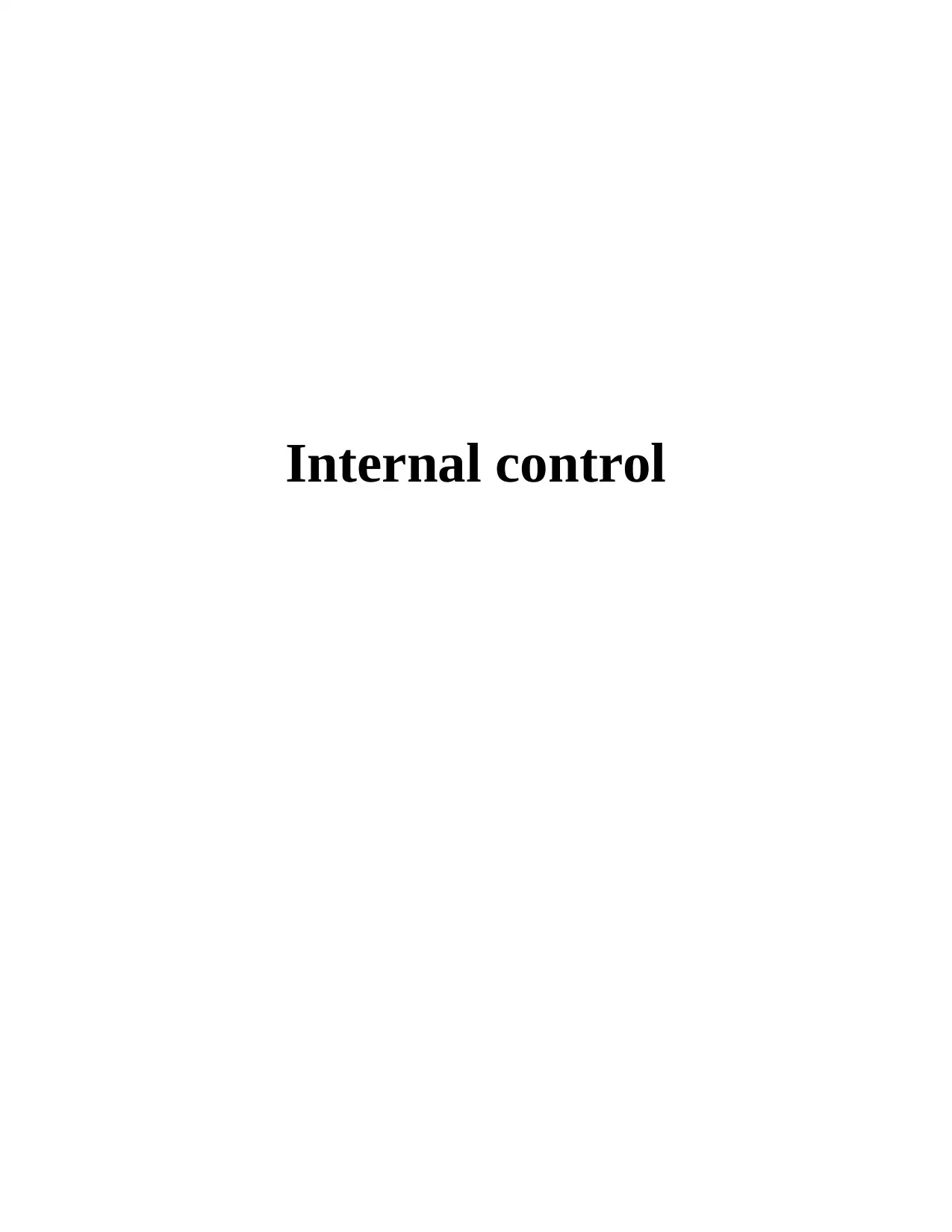
Internal control
Paraphrase This Document
Need a fresh take? Get an instant paraphrase of this document with our AI Paraphraser
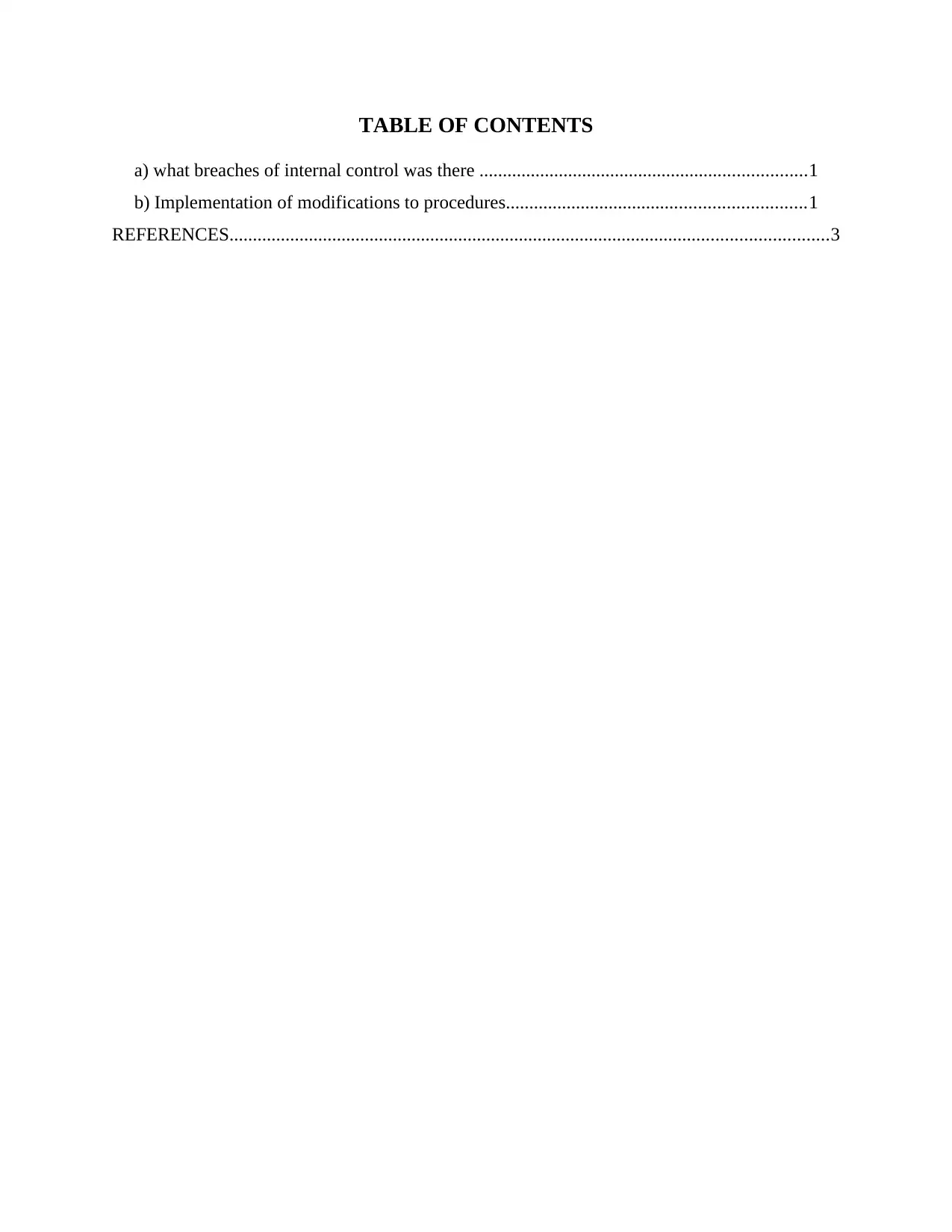
TABLE OF CONTENTS
a) what breaches of internal control was there ......................................................................1
b) Implementation of modifications to procedures................................................................1
REFERENCES................................................................................................................................3
a) what breaches of internal control was there ......................................................................1
b) Implementation of modifications to procedures................................................................1
REFERENCES................................................................................................................................3
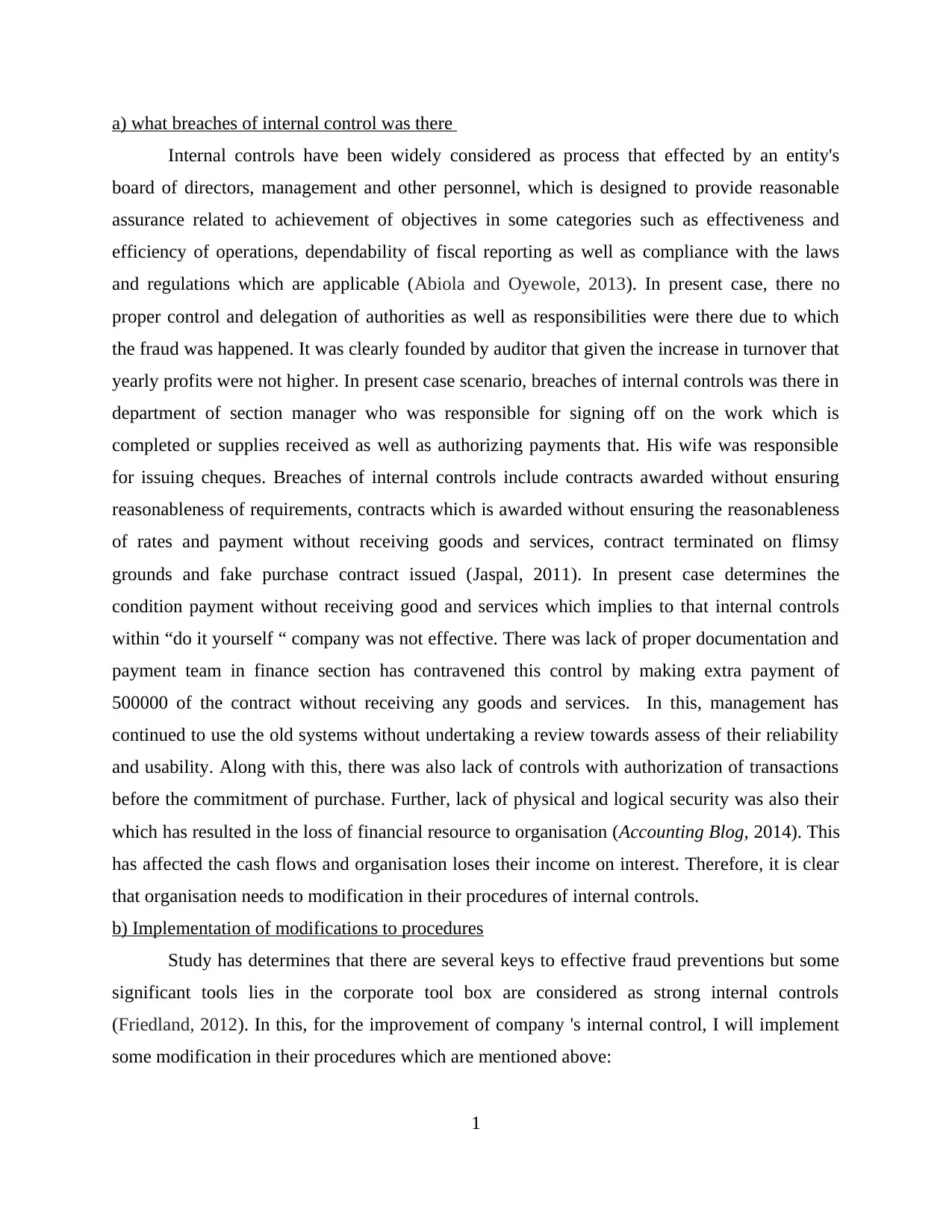
a) what breaches of internal control was there
Internal controls have been widely considered as process that effected by an entity's
board of directors, management and other personnel, which is designed to provide reasonable
assurance related to achievement of objectives in some categories such as effectiveness and
efficiency of operations, dependability of fiscal reporting as well as compliance with the laws
and regulations which are applicable (Abiola and Oyewole, 2013). In present case, there no
proper control and delegation of authorities as well as responsibilities were there due to which
the fraud was happened. It was clearly founded by auditor that given the increase in turnover that
yearly profits were not higher. In present case scenario, breaches of internal controls was there in
department of section manager who was responsible for signing off on the work which is
completed or supplies received as well as authorizing payments that. His wife was responsible
for issuing cheques. Breaches of internal controls include contracts awarded without ensuring
reasonableness of requirements, contracts which is awarded without ensuring the reasonableness
of rates and payment without receiving goods and services, contract terminated on flimsy
grounds and fake purchase contract issued (Jaspal, 2011). In present case determines the
condition payment without receiving good and services which implies to that internal controls
within “do it yourself “ company was not effective. There was lack of proper documentation and
payment team in finance section has contravened this control by making extra payment of
500000 of the contract without receiving any goods and services. In this, management has
continued to use the old systems without undertaking a review towards assess of their reliability
and usability. Along with this, there was also lack of controls with authorization of transactions
before the commitment of purchase. Further, lack of physical and logical security was also their
which has resulted in the loss of financial resource to organisation (Accounting Blog, 2014). This
has affected the cash flows and organisation loses their income on interest. Therefore, it is clear
that organisation needs to modification in their procedures of internal controls.
b) Implementation of modifications to procedures
Study has determines that there are several keys to effective fraud preventions but some
significant tools lies in the corporate tool box are considered as strong internal controls
(Friedland, 2012). In this, for the improvement of company 's internal control, I will implement
some modification in their procedures which are mentioned above:
1
Internal controls have been widely considered as process that effected by an entity's
board of directors, management and other personnel, which is designed to provide reasonable
assurance related to achievement of objectives in some categories such as effectiveness and
efficiency of operations, dependability of fiscal reporting as well as compliance with the laws
and regulations which are applicable (Abiola and Oyewole, 2013). In present case, there no
proper control and delegation of authorities as well as responsibilities were there due to which
the fraud was happened. It was clearly founded by auditor that given the increase in turnover that
yearly profits were not higher. In present case scenario, breaches of internal controls was there in
department of section manager who was responsible for signing off on the work which is
completed or supplies received as well as authorizing payments that. His wife was responsible
for issuing cheques. Breaches of internal controls include contracts awarded without ensuring
reasonableness of requirements, contracts which is awarded without ensuring the reasonableness
of rates and payment without receiving goods and services, contract terminated on flimsy
grounds and fake purchase contract issued (Jaspal, 2011). In present case determines the
condition payment without receiving good and services which implies to that internal controls
within “do it yourself “ company was not effective. There was lack of proper documentation and
payment team in finance section has contravened this control by making extra payment of
500000 of the contract without receiving any goods and services. In this, management has
continued to use the old systems without undertaking a review towards assess of their reliability
and usability. Along with this, there was also lack of controls with authorization of transactions
before the commitment of purchase. Further, lack of physical and logical security was also their
which has resulted in the loss of financial resource to organisation (Accounting Blog, 2014). This
has affected the cash flows and organisation loses their income on interest. Therefore, it is clear
that organisation needs to modification in their procedures of internal controls.
b) Implementation of modifications to procedures
Study has determines that there are several keys to effective fraud preventions but some
significant tools lies in the corporate tool box are considered as strong internal controls
(Friedland, 2012). In this, for the improvement of company 's internal control, I will implement
some modification in their procedures which are mentioned above:
1
⊘ This is a preview!⊘
Do you want full access?
Subscribe today to unlock all pages.

Trusted by 1+ million students worldwide
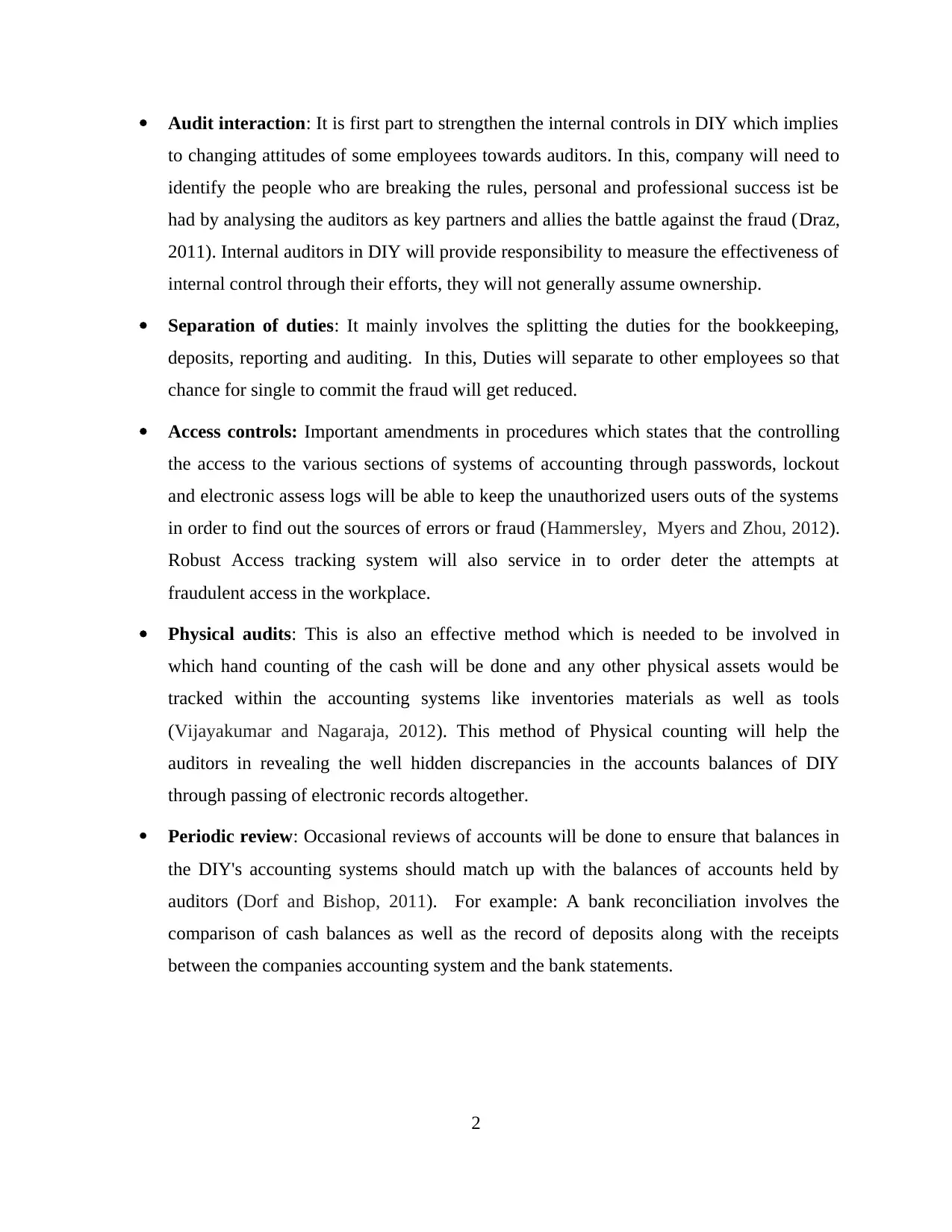
Audit interaction: It is first part to strengthen the internal controls in DIY which implies
to changing attitudes of some employees towards auditors. In this, company will need to
identify the people who are breaking the rules, personal and professional success ist be
had by analysing the auditors as key partners and allies the battle against the fraud (Draz,
2011). Internal auditors in DIY will provide responsibility to measure the effectiveness of
internal control through their efforts, they will not generally assume ownership.
Separation of duties: It mainly involves the splitting the duties for the bookkeeping,
deposits, reporting and auditing. In this, Duties will separate to other employees so that
chance for single to commit the fraud will get reduced.
Access controls: Important amendments in procedures which states that the controlling
the access to the various sections of systems of accounting through passwords, lockout
and electronic assess logs will be able to keep the unauthorized users outs of the systems
in order to find out the sources of errors or fraud (Hammersley, Myers and Zhou, 2012).
Robust Access tracking system will also service in to order deter the attempts at
fraudulent access in the workplace.
Physical audits: This is also an effective method which is needed to be involved in
which hand counting of the cash will be done and any other physical assets would be
tracked within the accounting systems like inventories materials as well as tools
(Vijayakumar and Nagaraja, 2012). This method of Physical counting will help the
auditors in revealing the well hidden discrepancies in the accounts balances of DIY
through passing of electronic records altogether.
Periodic review: Occasional reviews of accounts will be done to ensure that balances in
the DIY's accounting systems should match up with the balances of accounts held by
auditors (Dorf and Bishop, 2011). For example: A bank reconciliation involves the
comparison of cash balances as well as the record of deposits along with the receipts
between the companies accounting system and the bank statements.
2
to changing attitudes of some employees towards auditors. In this, company will need to
identify the people who are breaking the rules, personal and professional success ist be
had by analysing the auditors as key partners and allies the battle against the fraud (Draz,
2011). Internal auditors in DIY will provide responsibility to measure the effectiveness of
internal control through their efforts, they will not generally assume ownership.
Separation of duties: It mainly involves the splitting the duties for the bookkeeping,
deposits, reporting and auditing. In this, Duties will separate to other employees so that
chance for single to commit the fraud will get reduced.
Access controls: Important amendments in procedures which states that the controlling
the access to the various sections of systems of accounting through passwords, lockout
and electronic assess logs will be able to keep the unauthorized users outs of the systems
in order to find out the sources of errors or fraud (Hammersley, Myers and Zhou, 2012).
Robust Access tracking system will also service in to order deter the attempts at
fraudulent access in the workplace.
Physical audits: This is also an effective method which is needed to be involved in
which hand counting of the cash will be done and any other physical assets would be
tracked within the accounting systems like inventories materials as well as tools
(Vijayakumar and Nagaraja, 2012). This method of Physical counting will help the
auditors in revealing the well hidden discrepancies in the accounts balances of DIY
through passing of electronic records altogether.
Periodic review: Occasional reviews of accounts will be done to ensure that balances in
the DIY's accounting systems should match up with the balances of accounts held by
auditors (Dorf and Bishop, 2011). For example: A bank reconciliation involves the
comparison of cash balances as well as the record of deposits along with the receipts
between the companies accounting system and the bank statements.
2
Paraphrase This Document
Need a fresh take? Get an instant paraphrase of this document with our AI Paraphraser
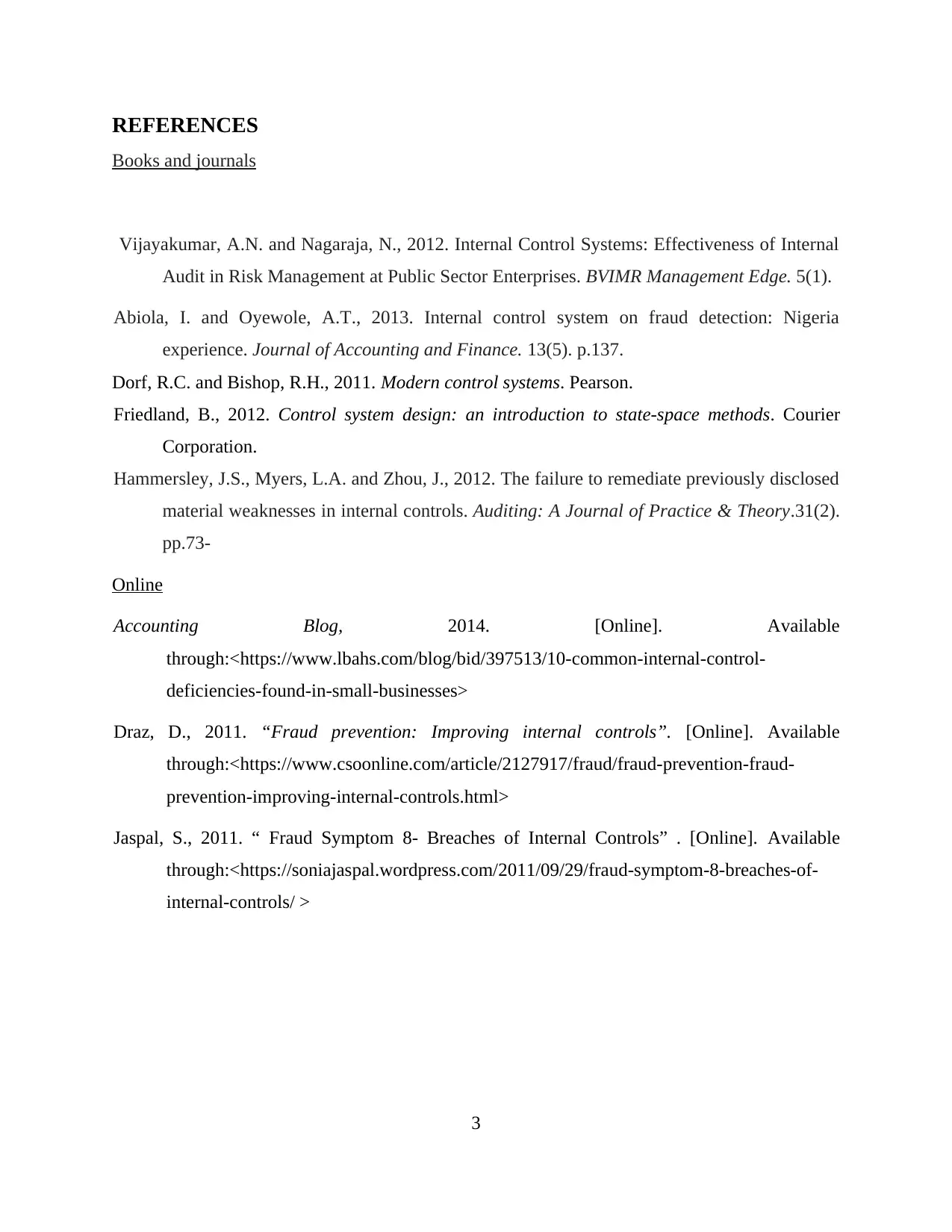
REFERENCES
Books and journals
Vijayakumar, A.N. and Nagaraja, N., 2012. Internal Control Systems: Effectiveness of Internal
Audit in Risk Management at Public Sector Enterprises. BVIMR Management Edge. 5(1).
Abiola, I. and Oyewole, A.T., 2013. Internal control system on fraud detection: Nigeria
experience. Journal of Accounting and Finance. 13(5). p.137.
Dorf, R.C. and Bishop, R.H., 2011. Modern control systems. Pearson.
Friedland, B., 2012. Control system design: an introduction to state-space methods. Courier
Corporation.
Hammersley, J.S., Myers, L.A. and Zhou, J., 2012. The failure to remediate previously disclosed
material weaknesses in internal controls. Auditing: A Journal of Practice & Theory.31(2).
pp.73-
Online
Accounting Blog, 2014. [Online]. Available
through:<https://www.lbahs.com/blog/bid/397513/10-common-internal-control-
deficiencies-found-in-small-businesses>
Draz, D., 2011. “Fraud prevention: Improving internal controls”. [Online]. Available
through:<https://www.csoonline.com/article/2127917/fraud/fraud-prevention-fraud-
prevention-improving-internal-controls.html>
Jaspal, S., 2011. “ Fraud Symptom 8- Breaches of Internal Controls” . [Online]. Available
through:<https://soniajaspal.wordpress.com/2011/09/29/fraud-symptom-8-breaches-of-
internal-controls/ >
3
Books and journals
Vijayakumar, A.N. and Nagaraja, N., 2012. Internal Control Systems: Effectiveness of Internal
Audit in Risk Management at Public Sector Enterprises. BVIMR Management Edge. 5(1).
Abiola, I. and Oyewole, A.T., 2013. Internal control system on fraud detection: Nigeria
experience. Journal of Accounting and Finance. 13(5). p.137.
Dorf, R.C. and Bishop, R.H., 2011. Modern control systems. Pearson.
Friedland, B., 2012. Control system design: an introduction to state-space methods. Courier
Corporation.
Hammersley, J.S., Myers, L.A. and Zhou, J., 2012. The failure to remediate previously disclosed
material weaknesses in internal controls. Auditing: A Journal of Practice & Theory.31(2).
pp.73-
Online
Accounting Blog, 2014. [Online]. Available
through:<https://www.lbahs.com/blog/bid/397513/10-common-internal-control-
deficiencies-found-in-small-businesses>
Draz, D., 2011. “Fraud prevention: Improving internal controls”. [Online]. Available
through:<https://www.csoonline.com/article/2127917/fraud/fraud-prevention-fraud-
prevention-improving-internal-controls.html>
Jaspal, S., 2011. “ Fraud Symptom 8- Breaches of Internal Controls” . [Online]. Available
through:<https://soniajaspal.wordpress.com/2011/09/29/fraud-symptom-8-breaches-of-
internal-controls/ >
3
1 out of 5
Related Documents
Your All-in-One AI-Powered Toolkit for Academic Success.
+13062052269
info@desklib.com
Available 24*7 on WhatsApp / Email
![[object Object]](/_next/static/media/star-bottom.7253800d.svg)
Unlock your academic potential
Copyright © 2020–2025 A2Z Services. All Rights Reserved. Developed and managed by ZUCOL.





